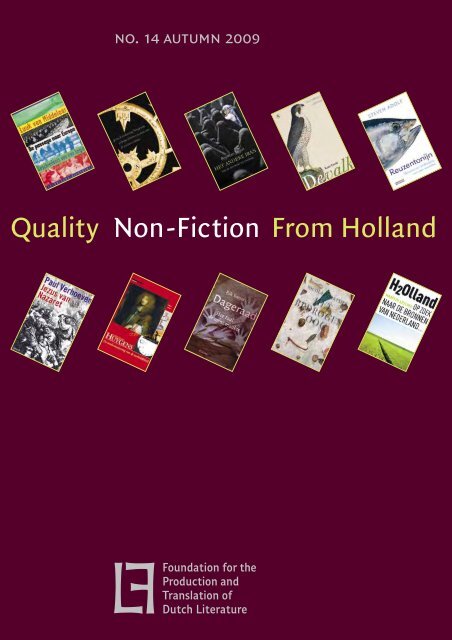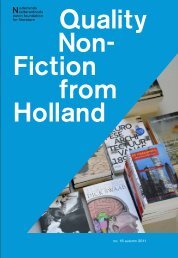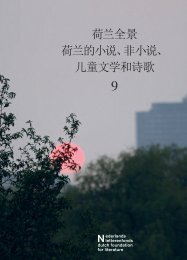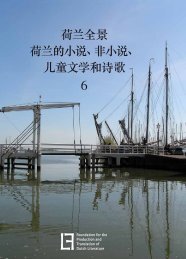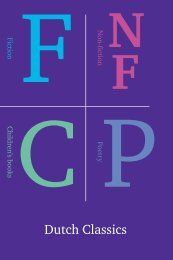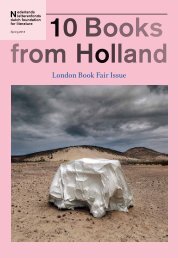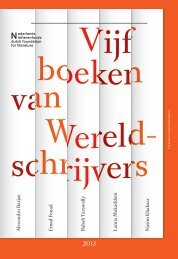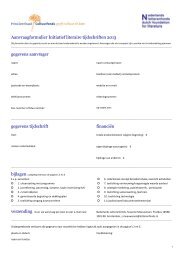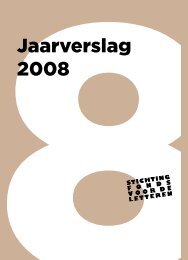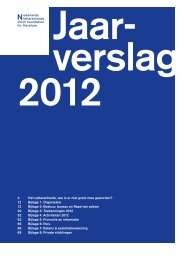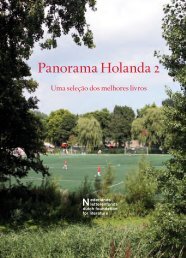Quality Non-Fiction From Holland - Nederlands Letterenfonds
Quality Non-Fiction From Holland - Nederlands Letterenfonds
Quality Non-Fiction From Holland - Nederlands Letterenfonds
- No tags were found...
You also want an ePaper? Increase the reach of your titles
YUMPU automatically turns print PDFs into web optimized ePapers that Google loves.
no. 14 autumn 2009<strong>Quality</strong> <strong>Non</strong>-<strong>Fiction</strong> <strong>From</strong> <strong>Holland</strong>
Luuk van Middelaarphoto sake elzingaJona LenderingPeyman Jafariphoto keke keukelaarKester Freriksphoto catherine hermansSteven Adolfphoto bob bronshoffphoto roy teephoto keke keukelaarphoto harry cockPaul VerhoevenRienk VermijRik SmitsNicolaas MatsierMaarten Asscher
Kester Freriks is the author ofNRC Handelsblad’s much-praised feature‘Birdwatching’ and its series ‘Scenes fromNature’, as well as fiction, poems andessays. His novel Hölderlin’s Tower (1981)was awarded the Van der Hoogt Prize,and his other books include the biographySecret East Indies. The life of MariaDermoût 1888-1962 (2000) and the novelDahlias and Snow (2008). His work hasbeen translated into German and English.*A magnificent book, a standard workin the field.nrc handelsbladI really like the opening scene of discoveryand enchantment, the cut-awayto White, by which Freriks manages hisown transformation from owner orhealer, to obsessive.robert macfarlane, author of The WildPlacesWhat makes The Falcon such a remarkablebook is that it so smoothly unites differentelements. It is both a novel andnon-fiction, encompassing three thousandyears of cultural history in prosefragments, poetry and illustrations. Ittouches upon all manner of things: thefalconry tradition, court customs, theecology of the wild bird, and all in chiselledprose.jan siebelink, author of kneeling on abed of violets*publishing detailsDe valk. Over valkerij en wilde vogels (2008)223 pp (77,000 words)With illustrations in colour andreferences4,000 copies sold*rightsAthenaeum-Polak & Van GennepSingel 262nl – 1016 ac Amsterdamt +31 20 551 12 62f +31 20 620 35 09e rights@querido.nll.van.der.leije@querido.nlwww.uitgeverijathenaeum.nl*For other translated titles by this authorsee our website www.nlpvf.nlKester FreriksThe FalconOn falconry and wild birdsAt seventeen Kester Freriks, a passionatebirdwatcher, found a peregrine falcon,Falco peregrinus, in the peatland of theeastern Netherlands. The bird of preyhad missed its quarry in the air andincurred minor injuries as a result.Freriks took it home and put it in acardboard box. Then he bought everythingthe secondhand bookseller inhis village could come up with on thesubject. He wanted to know what tofeed his peregrine.So began Freriks’ fascination with falconry,born out of the close affinity healready had for wild birds. Thirty-sixyears later he has united his two passionsin a unique book, which combines everyfacet of the cultural history of falconrywith observations on how falcons livein the wild. His account is gripping,indeed magnetic, with a poignantending.4For anyone interested in falconry, TheFalcon is a gift from heaven, just as thatoriginal bird had been for the author.Freriks expertly considers the emergence,rise and decline of falconry in Europe,especially Italy, Britain, Germany, France,Iceland, Sweden and the Netherlands.He writes warmly of Frederik II of Hohenstaufenof southern Italy, a thirteenth-centuryhands-on falconer and the author ofDe Arte Venandi cum Avibus (The Art ofHunting with Birds), ‘unsurpassed as amanual and study of the training ofhunting falcons’, in which he recommendsweighing the bird every morning. If she istoo light (they are always females, beinglarger than the male) she will not bepowerful enough to hunt. Too heavy andher appetite for hunting will weaken andshe may fly away.The falcon, the fastest bird in the world,capable of reaching speeds of threehundred kilometres an hour, is an unparalleledhunter. Falconers have a deep bondwith their raptors, which they repeatedlyallow to fly free. A bird returning from highin the sky to its master’s hand is a uniquespectacle, described lovingly here byFreriks. Clearly he felt liberated at beingable to express his lifelong passion for this‘beauty on the fist’ so infectiously, and withsuch verve and wisdom.* Brings together the world of tame falconswith that of wild birds of prey* Describes different methods of catchingfalcons: the Scots take young birds fromthe nest, while the Dutch catch adult birds* First ever account of the hazardous andthrilling seventeenth-century ‘falcon trips’to Iceland by Dutch ships
Steven Adolf is a correspondent inSpain, Portugal and Morocco forNRC Handelsblad, Elsevier and De Standaardand for various radio and televisioncompanies. He is the author of thebestselling Behind the Scenes in Spain(2001) and Behind the Scenes in Morocco(2005).*The story of the giant tuna illustratesthe breathtaking underwater declinetaking place all over the world. Adolfdishes it up with great versatility. Withthe help of excellent sources andagreeably intractable interviewees hehas brought many captivating facts tothe surface.nrc handelsbladGiant Tuna is an indictment of mankind’sinability to know when to stop.de volkskrant*publishing detailsReuzentonijn. Opkomst en ondergang vaneen wereldvis (2009)272 pp (75,000 words)With illustrations in black-and-whiteand references*rightsPrometheusHerengracht 540nl - 1017 cg Amsterdamt +31 20 624 19 34f +31 20 622 54 61e info@pbo.nlwww.pbo.nlSteven AdolfGiant TunaRise and fall of a global fishGiant Tuna tells the dramatic story of therise and fall of one of the world’s mostremarkable fish, which first put its stampon Western civilization in ancient times.The bluefin tuna is a living myth, a metallic-lookingtorpedo that can grow to overthree meters and weigh hundreds of kilos.It is one of the fastest fishes on earth. Aftertravelling thousands of kilometres acrossthe oceans, great shoals arrive in theStraits of Gibraltar every spring to reproducein the warm waters of the Mediterranean.People have awaited its arrival sinceprehistoric times, to catch it for its juicy redflesh. Centuries ago a Spanish monkwarned that overfishing would bring aboutthe tuna’s demise and ever since the end ofthe twentieth century, when the Japanesediscovered the bluefin tuna as the ultimateingredient for their sushi, his sombreprediction has seemed to be coming true.In a collective act of plunder, the worldpopulation of giant tuna has been all butwiped out in less than ten years.Steven Adolf looks at the significance ofgiant tuna across the centuries, fromPhoenician rule in the western Mediterranean,the Roman tuna industry and theSpanish ‘tuna aristocracy’ of the beachesaround Gibraltar to its mysterious disappearancefrom the North Sea. Now thebluefin tuna is playing a tragic key role onelast time, by symbolizing the destruction ofthe marine environment. A high-techfishing fleet, mostly of European manufacture,is fishing tuna out of the Mediterraneanwith lethal efficiency. Trade on theJapanese market, worth hundreds ofmillions of euro, has become a race to catchas much tuna as possible as quickly aspossible. The hunt for the last of the tunaamounts to the looting of our biological andcultural heritage, complete with fraud and aflourishing black market, which Europe hasshown little willingness to combat.Giant Tuna combines the little knownstory of a global fish with a grippingdocumentary about the dramatic consequencesof the globalisation of fisheries.The first generation to become familiarwith the underwater environment, throughdocumentaries by Jacques Cousteau, is nowwatching its irreplaceable riches run out. Avictim of our inability to manage the seassustainably, the bluefin tuna threatens todisappear for ever from our waters, ournets and our kitchens.5* Cultural-historical, biological and economicbiography of a fish in the traditionof Mark Kurlansky’s Cod* The black market in tuna explained, fromthe tuna mafia to tuna spies and tuna police* An indictment of short-term thinking byfishermen and fishmongers, politicians,governments and Japanese conglomerates,in the style of the film The End of the Line
Paul Verhoeven is the director of hitfilms including Robocop (1987), BasicInstinct (1992), Starship Troopers (1997)and Black Book (2006). Aside from thecinema he has another lifelong fascination:Jesus. After leaving the Netherlandshe applied to join the ‘JesusSeminar’ in California, a prominentassociation of liberal theologians whoaddress the question of what Jesus thehistorical figure actually said and did.Jesus of Nazareth is based on papersVerhoeven wrote for the Seminar.*An unexpectedly good book, andsoundly based too, a pleasant excursionfor both laymen and experts. Verhoevenbrings his instinct for drama and realismto the subject with excellent effect.nrc handelsbladA book about Jesus that swings like noother.de volkskrant*publishing detailsJezus van Nazaret (2008)288 pp (110,000 words)With notes and references21,000 copies sold*rightsMeulenhoffHerengracht 507nl - 1017 bv Amsterdamt +31 20 553 35 61f +31 20 535 31 30e p.claessens@meulenhoff.nlwww.meulenhoff.nl*rights soldPendo (Germany), 2009; Seven Stories(USA); Marsilio (Italy); Guerra e Paz(Portugal) and Bestun (Korea).Paul VerhoevenJesus of NazarethPaul Verhoeven, free spirit and directorof such films as Robocop and Basic Instinct,which brim with sex and violence, usedto be a member of the Pentecostal Churchand has been fascinated by the life ofJesus since childhood. He once asked hisfather whether Jesus felt pain when hewas crucified. Couldn’t God do anythingabout that? Receiving no answer, Verhoevencontinued searching. In his filmshe explores the outer limits of acceptability,and he does so again in this his firstbook, defending positions that certainlydo not square with the official teachingsof the Church.Most importantly Verhoeven asks whoJesus of Nazareth really was. How did helive? What did he stand for? For twothousand years appraisals of his characterhave been coloured by articles of faith,such as miracles and the resurrection, andiconic images of a skinny man on a crosswith resignation in his eyes. That is nothow Verhoeven sees him: ‘I look at Jesus asa person, I don’t think of him as the son ofGod. That’s a mythological Jesus, born outof our desire to see an image of God in ahuman being.’Verhoeven casts his eye over some of theless attractive features of Jesus the manwithout intending to desanctify him.He believes greater realism in tracingJesus’ life will further our understandingand sense of identification. Verhoevenhas an understandable preference forMark’s gospel, since it is full of the kindof engaging details he can use to createa captivating portrait of Jesus as abrilliant and passionate wordsmith,a rebel and provocateur, a bundle ofcontradictions.Verhoeven, film director that he is,presents ideas on how to make the ultimatefilm of the life of Christ. What would be thebest opening shot? This makes the bookhighly personal, a quest by a man determinedto leave no stone unturned, guidedby personal associations, writing more asan essayist than as a biographer. Thisfreethinking approach prompts questions.Did Jesus choose his own twelve disciples?Did he really believe he had to die? Whatexactly happened to the body? Verhoeven’sanswers make Jesus of Nazareth a provocativeand resolutely original book.* An engrossing book by a filmmakerfascinated by encounters with metaphysicsas well as raw reality* Intriguing insights from a director anddramatist in response to biblical texts* A new angle on Jesus as an exorcist,utopian and revolutionary6
Rik Smits is a philologist, a sciencejournalist and the author of books on awide range of subjects, including TheLeft-Handed Picador. On left- andright-handedness: facts and fabrications(1993; translated into German) and(with Liesbeth Koenen) the Handbookof Dutch (2004).*Smits chronicles the genesis of languagewith relish and at an enjoyablepace. He launches an original, personaltheory about the history of man theconversationalist.de volkskrantA richly informative and powerfullyarticulate book.intermediair*publishing detailsDageraad. Hoe taal de mens maakte (2009)272 pp (78,000 words)With illustrations in black-and-whiteand references4,000 copies sold*rightsNieuw AmsterdamPostbus 15511nl - 1001 na Amsterdamt +31 20 570 61 18t +31 20 570 61 99e hterborg@nieuwamsterdam.nlwww.nieuwamsterdam.nl*For other translated titles by this authorsee our website www.nlpvf.nlRik SmitsDawnHow language made manHow did the human ability to communicatethrough language arise? Unlikeinsects and animals we all command oneor more unique tongues, each with itsown variants, adding up to billions ofwords worldwide. In Dawn Rik Smitspresents a challenging vision of a subjectthat has not yet been fully researched.Smits’ view is that language cannotinitially have arisen as a system of communication.Indeed, from an evolutionaryperspective, everything suggests otherwise.Language, he claims, is a product ofthe integration of capacities each of whichevolved for its own reasons. Man is one ofnature’s most vulnerable creatures, and theonly substitute for strength is wisdom. Weare unique in being able to aim and throwaccurately. Our skills at calculation andestimation developed until they weresufficient to accommodate a system ascomplex as grammar.Only after our linguistic ability emergedcould we think logically and share ourreasoning with others, at which pointalmost everything we now call culture tookoff at a great rate. Smits concludes thatlanguage cannot have long predated theinvention of agriculture in the Middle East,some 14,000 years ago. This huge advancein civilization made abstract powers ofreasoning indispensable for the first time,along with highly developed concepts ofidentity, past, present and future, all ofwhich rely upon language.Smits’ explanation of the origins oflanguage throws new light on cave paintingsby Cro-Magnon man, whose masterpiecesof 40,000 to 15,000 years ago havebeen found at Altamira, Lascaux andelsewhere. Anatomically Cro-Magnonswere modern humans, but they had nolanguage in the modern sense. Their mindswere so fundamentally different from oursthat we would have had difficulty makingourselves understood to them. Theycertainly could not have conversed with us;they had no gods or religion comparable toours and probably no real sense of eroticism.These things dawned later, as a resultof the wonderful, accidental by-product ofevolution known as language.* Why language has nothing in commonwith systems of communication betweenanimals* What phantom limbs tell us about how ourbrains work* Why prehistoric Venus figurines have noerotic significance8
Nicolaas Matsier studied classicallanguages and philosophy and is theauthor of children’s books, story collections,essays, and the novels ClosedHouse (1994; translated into French andGerman) and The Forty-Eighth Hour(2005). He has also translated work byauthors including Lewis Carroll, StefanThemerson and Xenofon.*Matsier’s book is a wonderful guide.nrc handelsbladExtremely informative culturalhistoricalglimpses.vrij nederlandA brilliant book. With great affectionand sound documentation, Matsierdescribes numerous trompe l’oeils.het paroolThe Eye Deceived is a splendid piece ofwork, the product of a lifelong passion.nieuwsblad van het noorden*publishing detailsHet bedrogen oog. De kunst van detrompe-l’oeil (2009)255 pp (65,000 words)With illustrations in colour andblack-and-white, and references*rightsDe HarmonieHerengracht 555nl - 1017 bw Amsterdamt +31 20 624 51 81t +31 20 623 06 72e elouis@deharmonie.nlwww.deharmonie.nl*For other translated titles by this authorsee our website www.nlpvf.nlNicolaas MatsierThe Eye DeceivedThe art of the trompe l’oeilA trompe l’oeil is an artwork that triesnot to look like an artwork, a deceptive,realistically painted representationdesigned to fool the observer. So for besteffect a trompe l’oeil is not hung in a framebut discreetly positioned where it willmerge with its surroundings. Remarkably,given the prolific production of pictorialpractical jokes in the Low Countries,Nicolaas Matsier is the first person to writea Dutch monograph about this maverickgenre of European painting.The trompe l’oeil enjoyed its greatestpopularity during the Renaissance, butMatsier shows us a wide range of worksfrom all periods, including the twentiethcentury. He has selected 125 trompe l’oeilsfrom museums worldwide, interrelatingfacts about the artists and their work withhis own personal observations. Theyinclude a painting of a book of hours with,or so it seems, a flower pinned to it, abookcase that makes you want to pull outa book, a fly you want to bat away from apainted portrait, a notice board covered inletters and bills.Some artists conjured up whole rooms.Rembrandt’s pupil Samuel van Hoogstratenpainted life-sized pieces ofdomestic decor, and unsuspecting visitorsthought they were looking at rooms andcupboards they could walk straight into.Even more ambitious were the grandinteriors leading out onto spacious verandasbeyond which stretched arcadianlandscapes, or entire towns. Baroquearchitecture features ceilings on whichthe heavens stretch away, infinite andglorious.With their sophisticated trompe l’oeilsartists managed to mislead people andeven animals. One of the most strikingexamples is a small masterpiece by theDutch painter Cornelis Gijsbrechts. Itportrays the reverse side of a framedpainting. An unsuspecting visitor wouldpick it up, turn it around and see to hisembarrassment that he had been duped.The Eye Deceived is a seductive book aboutthat unique instant of artistic pleasure, theinstant when you are fooled into reachingfor an apple from a painted fruit bowl,waving to a painted figure at a window, ortrying to pull aside a curtain made of paint.* A subject rarely touched on by arthistorians* With the eye of a literary author, Matsiermakes comparisons across the centuries,connecting Rembrandt and Vermeer withcontemporary street artists like JulianBeever or graffiti artist Banksy* Includes an appendix full of tall storiesabout deceivers and the deceived9
Maarten Asscher, who trained as alawyer, has worked in publishing andas head of the Arts Department at theDutch Ministry of Education, Cultureand Science. He is currently managingdirector at Athenaeum Bookshop inAmsterdam. Since 1992 he has publishedseveral collections of stories andessays, as well as poetry and a novel(translated into German).*Maarten Asscher excels at essays andarticles on subjects you didn’t knowinterested you but are tempted into byhis enthusiasm, his thirst for historicalfacts, and his graceful, elegant style.de volkskrantSometimes light-footed, sometimesmelancholic, but always apposite.de morgenIt is rare for a writer to be so elegant,sharp and erudite at the same time.boek*publishing detailsH 2 Olland. Op zoek naar de bronnen vanNederland (2009)222 pp (55,000 words)With illustrations in black-and-whiteand references3,000 copies sold*rightsAugustusHerengracht 481nl - 1017 bt Amsterdamt +31 20 524 98 00f +31 20 627 68 51e mnagtegaal@amsteluitgevers.nlumatten@amsteluitgevers.nlwww.augustus.nl*rights soldLuchterhand (Germany)*For other translated titles by thisauthor see our website www.nlpvf.nlMaarten AsscherH 2 OllandA history of Dutch waterH 2 Olland is the least assertive book everwritten about the Netherlands. Here is aDutchman who confesses to feeling ill atease with his nationality, who during hislife, as he puts it, ‘has more often daydreamedof turning his back on theNetherlands than of crawling deeper intoits lap.’ That is nevertheless exactly what hedoes, he crawls into his country’s lap andshows it to us at its most intimate level.Maarten Asscher contemplates his nativeland by way of its water: the controlledinundation used by the Dutch to defendtheir country, the effects of water on theirurban lives, the flooding disasters they haveendured and the flood defences builtagainst them, their canals and land reclamation,their water consumption and loveof beaches, their skating mania and poldermanagement, their splendid mills andwater-towers, tunnels and bridges, thepoetry of their dykes and canal boats, theirpainting tradition and their royal family.He touches it all as if with a magic wand.The intimate feel of the book is heightenedby its concentration on a singlerepresentative of each phenomenon ortheme. The military applications ofmanaged flooding are made tangible inPampus Island and urban water in TheHague’s Hofvijfer (Court Lake), whiledisasters are epitomized by the horrificfloods of 1953 and skating by the Elfstedentochtrace. Asscher writes about his owndirect connection with each of them.Pampus is where he organized a birthdayparty for his children, a major tunnel underthe North Sea Canal tells his parents’ story,the Dutch coast is a walk, the De Valk Mill ahome, his wife seems to have made apersonal cult out of bottled spring-waterand he has some fairly eccentric bathinghabits of his own.Asscher has the eye of a collector, holdingup each subject for a moment like a devotedcustodian before setting it down in thecontext where it belongs. The wealth ofdetail, unusual angles and extraordinaryobservations, along with some hilariousquantitative data, give H2Olland a completenessapparently at odds with itslightness. This is an encyclopaedia inminiature, a paper boat for a pleasure tripthrough <strong>Holland</strong>.* Explains why Dutch windmills turnanticlockwise, why Dutch people consumeconsiderably less bottled water than otherEuropeans, and much else about the innateconnection between the Netherlands andwater* Combines research, narrative and reportageto offer a unique insight into somecharacteristic aspects of Dutch culture,landscape and history10
<strong>Non</strong>-<strong>Fiction</strong> Recent translationsMirjam BolleLet Me Tell You What a Day Here is Like(Ik zal je beschrijven hoe een dag er hier uitziet)Published in Finnish by Kirjapaja in 2008. Also in Danish(Høst & Søn), English (Audley Square), French (Denoël),German (Eichborn) and Swedish (Norstedts).*Chris BuskesEvolutionary Thinking(Evolutionair denken)Published in Spanish by Herder in 2009. Also in Chinese(Sichuan), Korean (OpenScience), German (Primus) andPolish (P.I.W.).*Douwe DraaismaThe Nostalgia Factory(De heimweefabriek)Published in Italian by Bruno Mondadori in 2009. Also inGerman (Galiani), Korean (Eco Livres) and Polish (Czarne).Ger GrootTwo Souls(Twee zielen)Published in Spanish by Sequitur in 2008.Also in Lithuanian (Aidai).*Stine JensenWhy Women Love Apes(Waarom vrouwen van apen houden)Published in Chinese by Flower City Press in 2008.Also in French (Seuil).*Luuc KooijmansThe Artist of Death(De doodskunstenaar)Published in Russian by Nauka/Kunstkamera in 2008.Also in English (Brill).11
For other translated titles see our website www.nlpvf.nlGeert MakThe Bridge(De brug)Published in English by Harvill Secker in 2008.Also in German (Siedler) and Greek (Metaichmio).*Fik MeijerGladiators(Gladiatoren)Published in Finnish by Otava in 2008. Also in Chinese(Guangxi), Czech (Aurora), English (Souvenir; St Martin’sPress), German (Artemis & Winkler), Hungarian (Gondolat),Italian (Laterza), Swedish (Historiska) and Turkish (Homer).*Piet MondriaanNeo-Plasticism(De nieuwe Beelding)Published in Portuguese by Cosacnaify in 2008.Cees NooteboomRed Rain(Rode regen)Published in French by Actes Sud in 2008. Also inGerman (Suhrkamp), Polish (W.A.B.), Russian (Text)and Spanish (Siruela).*Willem OtterspeerOrder and Loyalty(Orde en trouw)Published in Hungarian by Gondolat in 2008.Also in Chinese (Flower City Press).*Linda PolmanWar Games(De crisiskaravaan)Published in Italian by Bruno Mondadori in 2009.Also in English (Penguin), Norwegian (Arneberg)and Swedish (Leopard).12
<strong>Non</strong>-<strong>Fiction</strong> Recent translationsPaul SchefferThe Unsettled Land(Het land van aankomst)Published in German by Hanser in 2008. Also in Danish(Tiderne Skifter), English (Polity) and Polish (Czarne).*Govert SchillingThe Hunt for Planet X(De jacht op planet X)Published in English by Copernicus Books in 2008.*Abram de SwaanWords of the World(Woorden van de wereld)Published in Chinese by Flower City Press in 2008.Also in English (Polity) and Hungarian (Typotex).Roel van der VeenAfrica(Afrika van de Koude Oorlog naar de 21ste eeuw)Published in Chinese by Guangdong in 2009.Also in English (KIT).*Henk WesselingEurope’s Colonial Age(Europa’s koloniale eeuw)Published in French by Gallimard in 2009. Also inEnglish (Longman) and Swedish (Historiska).*Annejet van der ZijlSonny Boy(Sonny Boy)Published in Swedish by Lind in 2008. Also in Czech(Barrister & Principal), English (Faber & Faber), German(Kindler), Italian (Marsilio), Japanese (East Press)and Turkish (Alef).13
<strong>Quality</strong> <strong>Non</strong>-<strong>Fiction</strong> from <strong>Holland</strong> ispublished by the Foundation forthe Production and Translationof Dutch Literature. The bulletinis distributed free of charge toforeign publishers and editors.If you would like to receive <strong>Quality</strong><strong>Non</strong>-<strong>Fiction</strong> from <strong>Holland</strong> pleasecontact office@nlpvf.nl.www.nlpvf.nleditorsDick Broer, Maarten ValkencontributorsPek van Andel, Roelof van Gelder,Nies Medema, Willem Otterspeer,Victor SchiferlitranslationsLiz WatersdesignSuzan BeijerprintDrukkerij Mart.Spruijt bvnlpvfSingel 464nl - 1017 aw Amsterdamt +31 20 620 62 61f +31 20 620 71 79e office@nlpvf.nlwww.nlpvf.nl


